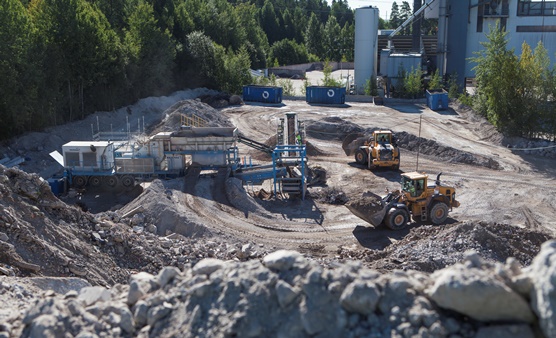The sub-project “CO2ncrete Solution” studies existing building stocks’, in practise concrete structures’, CO2 absorption potential during their use and recycling periods. The targets of sub-project “CO2ncrete Solution” are to research:
- How much Finlands existing concrete structures and building stock can uptake CO2 during their use period
- The total quantity of CO2 that concrete can uptake in recycling period.
- To research in real circumstances the best ways to maximize the potential carbon sink in recycling of concrete.
One of the main barriers to utilize recycled concrete is negative attitude of decision makers both in a communal and state level. Concrete association of Finland will produce and publish practical guidance for planning and implementing the use of concrete structures and materials as a CO2 sink in order to increase the use of recycled concrete.
Finland’s concrete stock’s carbon storage has been calculated
The sub-project conducted an analysis of the carbon storage of concrete in Finnish building stock. Key components in the carbon sequestration of concrete, hardness and exposure (to for example moisture and temperature) were considered in the analysis. The analysis estimates that the concrete stock’s carbon storage is around 5,2 million tons of carbon dioxide. The storage grows about 0,1 million tons annually. This means that the size of the carbon storage of the existing concrete stock is about 10% of the current annual emissions of the concrete industry in Finland.
Examining the carbon sequestration of recycled concrete
Recycled concrete acts the same way as regular concrete, however when it is crushed the surface area of the concrete that is exposed to air grows and carbonization intensifies. This has yet to be researched in depth and the project aims to explore this more.
A pilot was founded in spring 2021 that is used to calculate carbonization of crushed concrete. With the results future pilots where recycled concrete is used as a carbon storage can be precisely planned. These best practices are then disseminated and shared to municipalities thus helping reach the carbon neutrality goals.
Concrete structures bind carbon dioxide
The reaction causing carbon dioxide sequestration, i.e. carbonation of concrete, has been known for decades, but it has not been taken into account as a factor decreasing atmospheric carbon dioxide content. Carbonation of concrete can be significant for limiting of the climate change, because those parts of existing concrete structures and building stock surfaces in contact with air, absorb carbon dioxide continuously.
During the production process of cement limestone is decomposed to calcium oxide and carbon dioxide. According to the recent international research projects a significant part of carbon dioxide emitted in the production process of cement can be absorbed by concrete during the service life. During recycling concrete is usually crushed, which multiplies the specific surface of concrete in contact with air and the rate of absorption of carbon dioxide.
As an acidic gas carbon dioxide reacts with the alkaline cementitious matrix during carbonation of concrete so that carbon dioxide is a permanent part of cementitious matrix.
Because the environmental conditions and types of concrete in Finland are different compared with other countries, it is necessary to study carbon dioxide sequestration in the Finnish conditions.

© Finnish Association of Construction Product Industries
Time frame
Current
More information
-
Jussi Mattila, Finnish Concrete Industry, firstname.lastname@rakennusteollisuus.fi, tel. +358 400 637 224
-
Tiina Kaskiaro, Finnish Association of Construction Product Industries, firstname.lastname@rakennusteollisuus.fi, tel. +358 50 466 0297
-
Tommi Kekkonen, Finnish Association of Construction Product Industries, firstname.lastname@rakennusteollisuus.fi, tel. +358 50 350 8820